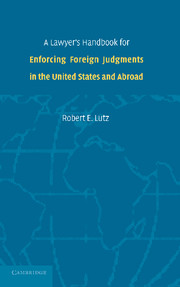Book contents
- Frontmatter
- Contents
- Preface
- Acknowledgments and Dedication
- Introduction
- PART ONE ENFORCING FOREIGN COUNTRY JUDGMENTS IN THE UNITED STATES
- I Overview
- II Phase One: Before Recognition
- III Phase Two: Converting the Judgment
- IV Phase Three: Executing a Converted Judgment in U.S. Courts
- V Conclusion
- Bibliography
- Instruments, Laws, and Other Materials
- PART TWO ENFORCEMENT OF JUDGMENTS ABROAD
- PART THREE THE FUTURE OF ENFORCING FOREIGN JUDGMENTS
- Bibliography
- Index
IV - Phase Three: Executing a Converted Judgment in U.S. Courts
Published online by Cambridge University Press: 16 November 2009
- Frontmatter
- Contents
- Preface
- Acknowledgments and Dedication
- Introduction
- PART ONE ENFORCING FOREIGN COUNTRY JUDGMENTS IN THE UNITED STATES
- I Overview
- II Phase One: Before Recognition
- III Phase Two: Converting the Judgment
- IV Phase Three: Executing a Converted Judgment in U.S. Courts
- V Conclusion
- Bibliography
- Instruments, Laws, and Other Materials
- PART TWO ENFORCEMENT OF JUDGMENTS ABROAD
- PART THREE THE FUTURE OF ENFORCING FOREIGN JUDGMENTS
- Bibliography
- Index
Summary
Once you have pursued a recalcitrant defendant halfway around the world to obtain a valid foreign judgment, you must still employ judicial means to enforce and execute the judgment. A general summary of execution procedures, which may vary from U.S. jurisdiction to U.S. jurisdiction, follows.
PLAINTIFF: LOCATING AND FREEZING ASSETS
If you have followed the checklist in Part One Section I, you will have located defendant's assets in the jurisdiction that can be used to satisfy the judgment, through private investigation and judicial discovery. State procedural rules govern execution of a judgment, so you should follow the procedure for execution of civil judgments in your state. For example, in California, a judgment creditor may apply to have a judgment debtor appear before the court to provide information in executing the judgment, by obtaining from the court an order to show cause. Be aware that, under The Hague Convention on Taking of Evidence Abroad in Civil or Commercial Matters, if the defendant is a national of a signatory country, a U.S. court may request through letters rogatory that documents or information be provided. However, California courts may now accord less deference to the foreign defendant's special protection under the Evidence Convention, based upon a U.S. Supreme Court decision. The Supreme Court held that the Convention does not provide either exclusive or mandatory procedures for obtaining documents from a foreign party located in a foreign jurisdiction. Rather, a court may choose to apply the Convention's provisions as an optional procedure.
- Type
- Chapter
- Information
- Publisher: Cambridge University PressPrint publication year: 2006



